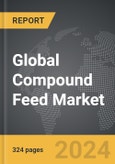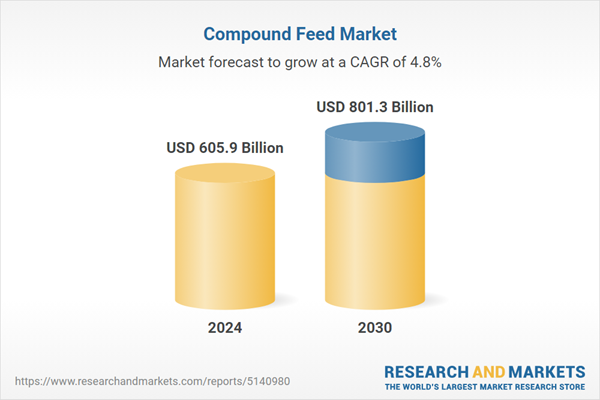The global market for Compound Feed was valued at US$605.9 Billion in 2024 and is projected to reach US$801.3 Billion by 2030, growing at a CAGR of 4.8% from 2024 to 2030. This comprehensive report provides an in-depth analysis of market trends, drivers, and forecasts, helping you make informed business decisions. The report includes the most recent global tariff developments and how they impact the Compound Feed market.
Segments: Ingredient (Cereals, Cakes & Meals, By-Products, Supplements); Livestock (Poultry, Swine, Aquaculture, Ruminants, Other Livestocks).
Geographic Regions/Countries: World; United States; Canada; Japan; China; Europe (France; Germany; Italy; United Kingdom; Spain; Russia; and Rest of Europe); Asia-Pacific (Australia; India; South Korea; and Rest of Asia-Pacific); Latin America (Argentina; Brazil; Mexico; and Rest of Latin America); Middle East (Iran; Israel; Saudi Arabia; United Arab Emirates; and Rest of Middle East); and Africa.
The analysts continuously track trade developments worldwide, drawing insights from leading global economists and over 200 industry and policy institutions, including think tanks, trade organizations, and national economic advisory bodies. This intelligence is integrated into forecasting models to provide timely, data-driven analysis of emerging risks and opportunities.
Global Compound Feed Market - Key Trends and Drivers Summarized
What Is Compound Feed and Why Is It Vital to Modern Livestock Production?
Compound feed plays a pivotal role in modern livestock farming by providing a balanced diet tailored to the nutritional needs of various animal species. It consists of a mixture of ingredients such as grains, proteins, vitamins, minerals, and additives that together ensure optimal growth, reproduction, and overall health in livestock. Unlike traditional feeds, which might rely on single-source nutrition, compound feed is scientifically formulated to deliver a complete nutritional profile. This is especially important in intensive farming operations, where animals are raised for maximum productivity within confined spaces. Whether for poultry, cattle, swine, or fish, compound feed enables farmers to control and optimize the nutritional intake of their animals, which directly translates into better yield, improved product quality, and enhanced animal welfare. The versatility of compound feed also makes it applicable across diverse farming environments, from small-scale local farms to large industrial livestock operations. With the growing global demand for meat, dairy, and other animal-derived products, the role of compound feed is becoming increasingly essential in ensuring both the sustainability and efficiency of livestock production.How Have Technological Innovations Shaped the Compound Feed Industry?
The compound feed industry has experienced significant transformations due to technological advancements in both feed formulation and manufacturing processes. Precision nutrition is one such breakthrough, allowing for the development of feed mixtures that are fine-tuned to the specific nutritional requirements of animals at various life stages. Technologies such as near-infrared spectroscopy (NIRS) and predictive analytics are now being used to analyze the composition of raw feed ingredients in real-time, ensuring that compound feed formulations consistently meet stringent quality standards. Moreover, automation in feed mills has greatly improved the efficiency of production, with sophisticated machinery capable of mixing ingredients with extreme accuracy, reducing wastage, and ensuring a more uniform feed product. Another key technological development is the incorporation of additives like enzymes, probiotics, and organic acids into compound feed. These additives not only improve digestibility and nutrient absorption but also help boost immunity and reduce the need for antibiotics, addressing growing concerns around antibiotic resistance in animal farming. Innovations in storage and distribution, including advanced packaging solutions that preserve feed quality for longer periods, have also helped optimize the supply chain in the compound feed industry.How Is Compound Feed Applied Across Different Sectors and Geographies?
Compound feed has diverse applications across a variety of livestock sectors, making it a cornerstone in the global agricultural economy. In poultry farming, for instance, it is essential for maximizing egg production and improving the quality of poultry meat, with tailored formulations designed to support growth, reproductive performance, and health. Similarly, in dairy farming, compound feed plays a crucial role in improving milk yield and enhancing its nutritional profile by ensuring that dairy cows receive a balanced diet rich in proteins and minerals. In the swine industry, it is used to ensure rapid growth and high-quality pork production, while in aquaculture, compound feed helps to promote healthy fish growth, which is vital given the increasing global reliance on farmed fish for protein. The use of compound feed is not only prominent in developed regions like North America and Europe but is also expanding rapidly in emerging economies across Asia, Latin America, and Africa. As countries in these regions urbanize and experience shifts in dietary preferences towards more animal-based proteins, the demand for compound feed is increasing. This global expansion has encouraged compound feed manufacturers to adapt their formulations to the specific needs of local livestock species and agricultural practices, ensuring the optimal performance of animals in various environmental conditions.What Is Driving the Growth of the Compound Feed Market?
The growth in the compound feed market is driven by several factors, reflecting the changing dynamics of livestock farming, consumer preferences, and technological advancements. One of the primary drivers is the rising global demand for animal-based proteins, including meat, dairy, and fish, particularly in developing economies where increasing disposable incomes are altering dietary habits. This shift has placed greater pressure on livestock producers to meet demand efficiently, which in turn spurs the adoption of compound feed to enhance productivity. Another critical factor is the increased awareness of animal nutrition and welfare among consumers, which has led to a growing preference for high-quality, sustainably produced animal products. In response, farmers are increasingly turning to compound feed that not only improves yield but also supports animal health and reduces the environmental impact of farming operations. Technological advancements, such as precision feeding systems and the use of data analytics in feed formulation, are also driving market growth by enabling more efficient and cost-effective feed production. Additionally, regulatory pressures, particularly in regions with strict animal welfare and environmental standards, are pushing livestock producers to adopt compound feed solutions that minimize resource use and lower greenhouse gas emissions. Furthermore, the expansion of organized livestock farming, particularly in countries with developing agricultural sectors, is accelerating the demand for compound feed, as these operations rely heavily on scientific nutrition management to remain competitive. Collectively, these factors are shaping the growth trajectory of the compound feed market, with an increasing focus on sustainability, efficiency, and technological integration in livestock production.Report Scope
The report analyzes the Compound Feed market, presented in terms of units. The analysis covers the key segments and geographic regions outlined below.Segments: Ingredient (Cereals, Cakes & Meals, By-Products, Supplements); Livestock (Poultry, Swine, Aquaculture, Ruminants, Other Livestocks).
Geographic Regions/Countries: World; United States; Canada; Japan; China; Europe (France; Germany; Italy; United Kingdom; Spain; Russia; and Rest of Europe); Asia-Pacific (Australia; India; South Korea; and Rest of Asia-Pacific); Latin America (Argentina; Brazil; Mexico; and Rest of Latin America); Middle East (Iran; Israel; Saudi Arabia; United Arab Emirates; and Rest of Middle East); and Africa.
Key Insights:
- Market Growth: Understand the significant growth trajectory of the Cereals Ingredient segment, which is expected to reach US$253.2 Billion by 2030 with a CAGR of a 4.5%. The Cakes & Meals Ingredient segment is also set to grow at 4.9% CAGR over the analysis period.
- Regional Analysis: Gain insights into the U.S. market, valued at $158.6 Billion in 2024, and China, forecasted to grow at an impressive 7.3% CAGR to reach $175.0 Billion by 2030. Discover growth trends in other key regions, including Japan, Canada, Germany, and the Asia-Pacific.
Why You Should Buy This Report:
- Detailed Market Analysis: Access a thorough analysis of the Global Compound Feed Market, covering all major geographic regions and market segments.
- Competitive Insights: Get an overview of the competitive landscape, including the market presence of major players across different geographies.
- Future Trends and Drivers: Understand the key trends and drivers shaping the future of the Global Compound Feed Market.
- Actionable Insights: Benefit from actionable insights that can help you identify new revenue opportunities and make strategic business decisions.
Key Questions Answered:
- How is the Global Compound Feed Market expected to evolve by 2030?
- What are the main drivers and restraints affecting the market?
- Which market segments will grow the most over the forecast period?
- How will market shares for different regions and segments change by 2030?
- Who are the leading players in the market, and what are their prospects?
Report Features:
- Comprehensive Market Data: Independent analysis of annual sales and market forecasts in US$ Million from 2024 to 2030.
- In-Depth Regional Analysis: Detailed insights into key markets, including the U.S., China, Japan, Canada, Europe, Asia-Pacific, Latin America, Middle East, and Africa.
- Company Profiles: Coverage of players such as Alltech, Archer Daniels Midland Company, Cargill, Inc., Charoen Pokphand Foods Public Company Limited, Feed One Co., Ltd. and more.
- Complimentary Updates: Receive free report updates for one year to keep you informed of the latest market developments.
Some of the 43 companies featured in this Compound Feed market report include:
- Alltech
- Archer Daniels Midland Company
- Cargill, Inc.
- Charoen Pokphand Foods Public Company Limited
- Feed One Co., Ltd.
- ForFarmers N.V.
- Guangdong Haid Group Co. Ltd.
- J.D. Heiskell & Co.
- Kent Nutrition Group, Inc.
- Land O'Lakes, Inc.
- New Hope Group SA
- Nutreco NV
Tariff Impact Analysis: Key Insights for 2025
Global tariff negotiations across 180+ countries are reshaping supply chains, costs, and competitiveness. This report reflects the latest developments as of April 2025 and incorporates forward-looking insights into the market outlook.The analysts continuously track trade developments worldwide, drawing insights from leading global economists and over 200 industry and policy institutions, including think tanks, trade organizations, and national economic advisory bodies. This intelligence is integrated into forecasting models to provide timely, data-driven analysis of emerging risks and opportunities.
What’s Included in This Edition:
- Tariff-adjusted market forecasts by region and segment
- Analysis of cost and supply chain implications by sourcing and trade exposure
- Strategic insights into geographic shifts
Buyers receive a free July 2025 update with:
- Finalized tariff impacts and new trade agreement effects
- Updated projections reflecting global sourcing and cost shifts
- Expanded country-specific coverage across the industry
Table of Contents
I. METHODOLOGYII. EXECUTIVE SUMMARY2. FOCUS ON SELECT PLAYERSIII. MARKET ANALYSISSOUTH KOREAREST OF ASIA-PACIFICARGENTINABRAZILMEXICOREST OF LATIN AMERICAIRANISRAELSAUDI ARABIAUNITED ARAB EMIRATESREST OF MIDDLE EASTIV. COMPETITION
1. MARKET OVERVIEW
3. MARKET TRENDS & DRIVERS
4. GLOBAL MARKET PERSPECTIVE
UNITED STATES
CANADA
JAPAN
CHINA
EUROPE
FRANCE
GERMANY
ITALY
UNITED KINGDOM
SPAIN
RUSSIA
REST OF EUROPE
ASIA-PACIFIC
AUSTRALIA
INDIA
LATIN AMERICA
MIDDLE EAST
AFRICA
Companies Mentioned (Partial List)
A selection of companies mentioned in this report includes, but is not limited to:
- Alltech
- Archer Daniels Midland Company
- Cargill, Inc.
- Charoen Pokphand Foods Public Company Limited
- Feed One Co., Ltd.
- ForFarmers N.V.
- Guangdong Haid Group Co. Ltd.
- J.D. Heiskell & Co.
- Kent Nutrition Group, Inc.
- Land O'Lakes, Inc.
- New Hope Group SA
- Nutreco NV
Table Information
| Report Attribute | Details |
|---|---|
| No. of Pages | 324 |
| Published | April 2025 |
| Forecast Period | 2024 - 2030 |
| Estimated Market Value ( USD | $ 605.9 Billion |
| Forecasted Market Value ( USD | $ 801.3 Billion |
| Compound Annual Growth Rate | 4.8% |
| Regions Covered | Global |









